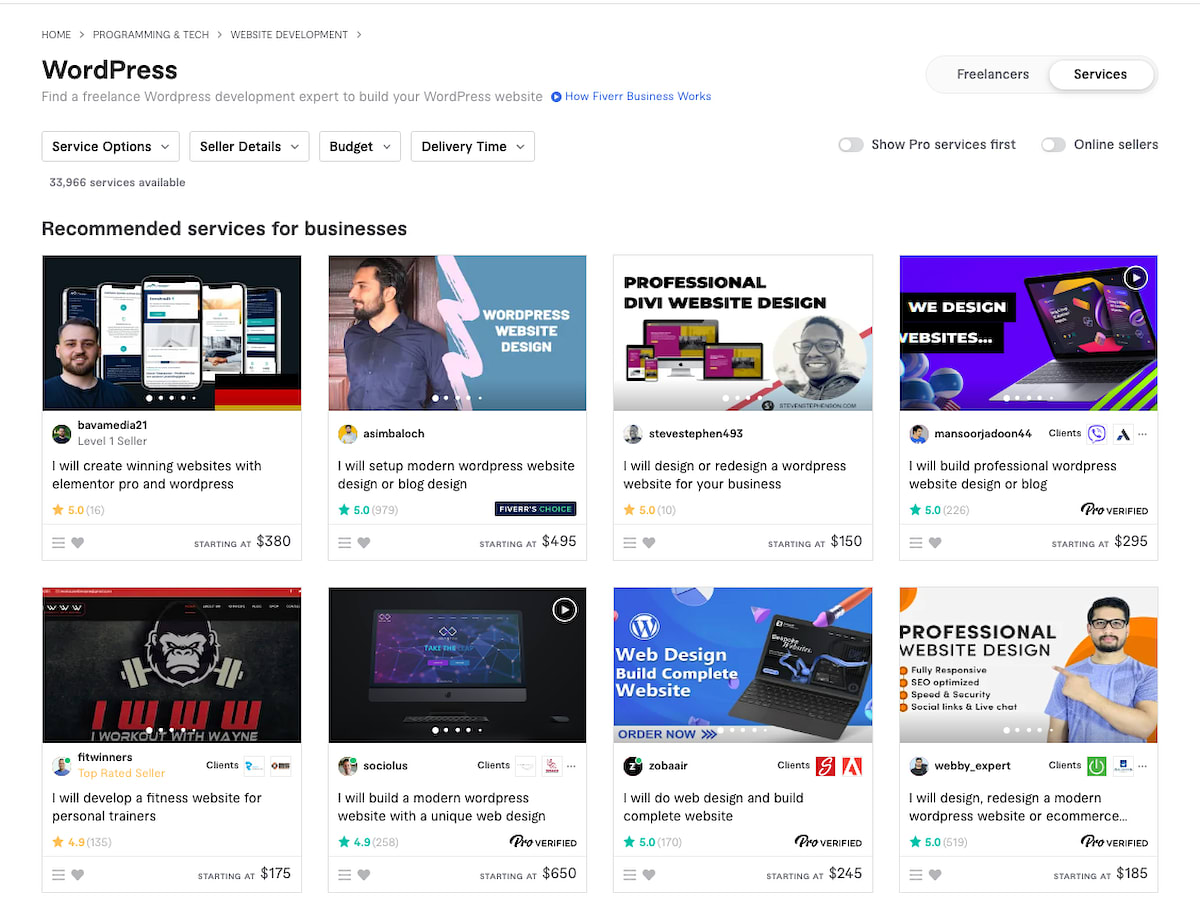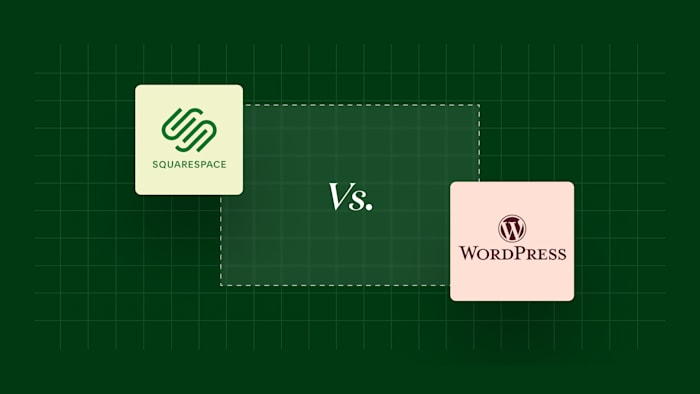How to build a WordPress website for your small business
Learn the steps required to build a professional WordPress site for your business. Anyone can build a WordPress site. And we show you how!
 February 2, 2023
February 2, 2023 14 minute reading
14 minute reading
Is it possible to build a website without any programming knowledge whatsoever? Duh, of course it is! WordPress has made it so that anyonecan build a websitewithout being a professional web developer.
WordPress is a highly flexible system with an enormous community surrounding it. In 2022, nearly2,500 people contributed codeto the core WordPress system. Wow!
Let's take a deep dive into how to:
Set up your own WordPress site, including registering a domain and purchasing web hosting.
Download and install WordPress.
CustomizE a beautiful theme to make your WordPress site look professional.
Add content to your
, such as pages and blog posts.
Enhance your WordPress installation with extra plugins from WordPress.org's vast library of plugins.
OptimizE your WordPress website so that it has better chances of ranking well on search engines.
What is WordPress and why should small businesses use it?
WordPressis a popular open-source content management system (CMS). Open source means that the code for WordPress is completely open and everyone can see precisely how it works. This makes it possible for thousands of experts to audit the code to make sure it's secure.
There are two ways to get WordPress: Installing it yourself at a web host (calledself-hosted WordPress) or paying for a subscription at WordPress.com which is the commercial offering of WordPress.
For this guide, we'll be talking about installing it yourself (it's super easy!) because self-hosted installations have a lot more flexibility.WordPress is highly extensible. The platform was designed around a concept called "plugins." These are small pieces of independent code that enhance WordPress's basic functionality. Many of the plugins are free and they offer everything fromsearch engine optimization (SEO)to social media tools to contact forms and countless other additional features.
Installing these pluginsis as easy as searching the WordPress plugin repository and clicking "Install." We'll dig into precisely how to do this below.It isn't necessary to hire an expert to manage your WordPress site, but many businesses hire freelancers. Freelancers can quickly add highly sophisticated features to your WordPress site at a fraction of the cost of agencies or full-time employees. WordPress’s design makes this extremely simple.
What are the benefits of using WordPress for a small business website?
WordPress is cost-effective and provides excellent value. Small businesses on a shoestring budget can get a powerful website up and running with little-to-no financial investment.
"While looking to create my website," saysCrystal Noe, owner ofNoe Compliance, an advanced compliance services firm for businesses in the finance and crypto sectors, "I sought out the most affordable hosting solution and site builder with template designs suiting my financial compliance consultancy.
我降落在WordPress。有替代options with lots of beautiful templates, but they didn't suit my business. It's easy to get carried away and swipe your credit card for an expensive site builder, only to realize their designs, although gorgeous, don't suit your needs."
The platform also has many customization options and free plugins that extend the basic functionality.
WordPress allows small businesses to run an enterprise-grade website platform without enterprise-level investment. As of 2021, WordPress was alreadypowering 40% of the internet. And the platformpowers nearly 30%of the world's top 1 million websites.
How to set-up a Wordpress website?
In the past, setting up WordPress was a bit of a nightmare for people with no web development experience. You needed to download the package, extract the files, upload them, create a database...
A painful process.
Fortunately, web hosts have made it, so you don't need to go through these hassles. Basically, most hosts offer you an easy wizard to set up your WordPress website.
That's the easy part.
It's the maintenance that’s a headache, and often requires thehelp of a web developer.

Keep reading to learn how to build a functioning Wordpress website for your business, or save time and hire a Wordpress expert today.
Find servicesStep 1: Buy web hosting
To find hosting for your WordPress site, search forLinux HostingorShared Linux Hostingor simply search for Wordpress hostings.
For example,Hostingeroffers the following packages:

Additionally, by looking at Hostgator's pricing for shared Linux hosting, we see the following:

Be sure to read the fine print. The discounts above are only valid for the first invoice. So the Business Plan, which is the only one offering unlimited websites, will be $17.95 a month after the first month. The domain is also only free in the first year.
GoDaddy has similarly priced packages:

Again, be sure to read the fine print. The prices above are for a three-year term.
The basic WordPress hosting requirements are:
Linux server
PHP capability (this is the programming language that WordPress is written in)
MySQL database (this is the database used by WordPress)
CPanel (this is the basic Control Panel used to manage everything related to your web host)
Bonus requirements are:
High bandwidth
High storage
Keep it simple:You can always upgrade later once your site has more traffic.
Step 2: Buy and choose a domain
After clicking the "Sign Up" button on your chosen hosting package, you'll be prompted to choose a domain.
There are millions of domains in the world. One of the largest challenges these days is to find a dot com domain that hasn't been taken.
The ending of the domain — .com, .eu, .net — is called the TLD, or Top Level Domain.
The .com TLD is considered widely generic and commercial. I recommend trying to find a domain that ends in .com.
You will likely need to test a few options to find one that is available. If you absolutely hate the .com domain you find, you can try a custom TLD such as .site, .club, .company, and so one.
Step 3: Install WordPress
Hostinger makes itsuper easyto install WordPress! Just click the auto installer for WordPress and it walks you through the installation process.

Hostinger Auto installer
在选择Auto-Installer WordPress,Hostinger walks you through the installation process. All you have to do is fill in the details and, voila, you have WordPress!

Hostinger auto-installer for WordPress
在选择Auto-Installer WordPress,Hostinger walks you through the installation process. All you have to do is fill in the details and, voila, you have WordPress!
Easy peasy!
Next steps with WordPress: The good, the bad, and the ugly!
Okay, that was the easy part!
It's no secret that WordPress can have its quirks. The platform's extreme flexibility means that it can be a little troublesome sometimes. But the reason it's the most popular CMS in the world is precisely because it's so incredibly versatile and scales phenomenally.
“怪癖”通常不会发生如果你坚持智慧h the default theme and install zero plugins. But if you wanted simplicity over flexibility, you probably would have chosenSquarespace over WordPress.
WordPress's power comes from the fact that it has over 10,000 free themes to choose from, andmore than 60,000 plugins!

Themes are a piece of cake if you like themexactlyas they are. But people often want tocustomize them. If you are not a web developer, that can get frustrating. And, a common problem with WordPress is that too many plugins and themes can result in conflicts, requiringweb debugging.
It's not as simple as saying, "Oh, just uninstall the plugin that is causing the conflict!" Some of thosepluginsare crucial for your website's success in search engines.
For example, so-called "caching" plugins are vital forspeeding up a website. This is an importantsearch engine ranking factor. But these plugins are notorious for their potential to "break" certain other plugins.
Two ways around this are to:
Go by trial and error, installing and uninstalling plugins as needed to see which work best on your site. This is a valid strategy if you're strapped on budget and have some time on your hands.
The other option is to hire an expertwebsite specialistwho knows which plugins work best with other plugins and themes. This will save you both time and money in the long term.
Okay, that was the scary part. If you want to roll up your sleeves and DIY, here's how to do it:
Step 4: Select a theme
Wordpress Themes: The Good
The "good" about selecting a theme is that there are so many to choose from. You can also pay a small fee for premium themes which can go a really long way to give you the power to customize them without any knowledge of programming.
One example of such a theme is theDivi Themeby Elegant Themes.

A great mantra to follow when selecting a theme is "If it's supposed to work, it will work." That means that: The second it starts getting complicated, either drop it as a choice or get someone toinstall and customize the themefor you.
WordPress's themes repositoryalso has tons of themes to choose from.
If you're doing it on your own, it's best to start with something simple and change it later.
Using the feature filter, you can choose themes based on subject, such as themesspecialized for blogs, portfolios, news, entertainment, and other topics.

Photography theme on Wordpress.org Themes
By clicking "Commercial Themes" on the top right, you can get access to themes that are available for a fee.
If you want to install from WordPress's official repository, simply go to "Appearance" → "Themes" in your WordPress admin section and then click "Add New" at the top. Here, you can search as if on the WordPress.org website and click the Install button on the theme you want to install.
After clicking install, click the Activate button on the theme.
Other sources of excellent themes includeTheme ForestandColorLib.
Wordpress Themes: The Bad
好吧,让我们看看W的潜在的“坏”ordPress themes, and how to resolve it::
Things start to get complicated when you need to:
Download and install a theme from an external repository. (This is more common than you might think because external repositories hold excellent premium themes.)
Customize the theme more than its options allow.
Debug the theme.
Like all things WordPress, the developers have gone out of their way to make it possible for non-programmers to customize and tweak things.
But because something is possible doesn't mean it's easy.
Every theme offers unique customization options. Some let you customize the colors and font. Others let you specify the layout of the theme.
To access all the customization options, go to "Appearance" → "Customize" on the left menu of the admin section.

A few things can go wrong here:
The page looks different on the customization page than it does when you're viewing the live version.
The option you want changed doesn't exist.
Because I am a programmer by training, I always rolled up my sleeves to try and "hack" themes to make them work. But, let me tell you, this is extremely frustrating! It is also phenomenally time-consuming! Now that I am a full time writer, I just don't have the time to do it, and my skills have become outdated. It's much faster to just hire a pro who is involved in the WordPress scene and knows what they're doing.
Sometimes, you find a theme that is "almost" right, but not quite. In that case, it is possible to create a "child theme" that builds on the main theme. A programmer can code this child theme and get it up and running much faster than if they were creating an entirely new theme from scratch.
Donny Gamble, founder ofRetirementInvestments.com, a personal finance website that teaches individuals how to invest on their own terms, has personally built over 50 websites using WordPress. He suggests the following strategy regarding themes:
"The great thing about WordPress is that you can use a child theme or theme framework like GeneratePress that gives you the ability to start with a template that you can build and customize off of. Most of my websites use a child theme and I hire a freelance web developer to customize it based upon the functionality that I need."
Another powerful option to customize WordPress themes is to use a Wordpress page/theme builder plugin such as Elementor or Oxygen Page Builder. This lets you customize any WordPress theme using a drag-and-drop editor. It's well-suited for people with no coding experience.
And that brings us to the "ugly."
WordPress themes: The ugly
And then there is the possibility that a particular theme-plugin-combination conflicts and brings your entire site down. This sometimes happens when you update a plugin or theme. It worked yesterday and then, bam, your site is broken!
This puts people in a catch-22 regarding maintenance: It's crucial to regularly update WordPress because the vast majority of hacks the platform suffers come from outdated plugins. But updating the site can also "break" it.
So, what do you do?
As mentioned previously, a bit of programming knowledge can end up costing you a lot more in lost time. It is much easier to hire someone at a reasonable cost to do the website maintenance for you, or to jump in tofix a broken site.
Backing up your WordPress siteregularly is also crucial.
Step 5: Installing plugins
The good, bad, and ugly of WordPress plugins is very similar to themes: You have an enormous choice, and each can bring tremendous value to the site. But too much of a good thing can result in:
Plugin/theme conflicts
Potential security holes if they are not regularly maintained
Certain plugins are absolutely essential, however. I recommend using the following plugins as a minimum:
SEO Plugin such RankMath and Yoast SEO.
Security Plugin such asWordfenceor Sucuri.
Tracking plugins such asGA谷歌分析, Jetpack, or HotJar
A forms plugin such asNinja FormsorEverest Forms.
Appearance-related plugins, depending on your needs. This could be a carousel plugin for image galleries, a "Lightbox" plugin for image-heavy websites, or a menu plugin for better-looking menus.
A cookie and privacy plugin to block cookies such asWP GDPR ComplianceandCookie Notice For GDPR & CCPA.
Use with caution:Caching plugins are essential for improving your site's speed. But these sometimes conflict with other plugins. We recommendoutsourcing your Wordpress servicesto choose the right caching plugin, and configure it so it results in minimal conflict with other plugins.
To install a new plugin, do the following:
Click "Plugin" → "Add New" in the Admin menu on the left of the admin section.
Search for the plugin you want to install, such as Rank Math for SEO.

Then click the Install Now button followed by "Activate" after the plugin has been installed.
Unfortunately, there's no standard location for a plugin's menu item in the admin section. This can be quite frustrating when you're looking for a plugin's settings in the menu.
Rank Math creates its own top-level menu item in the Admin menu, making it somewhat easier to find. Clicking on this menu item takes you to a plethora of options that can tweak your website's SEO performance. If you know SEO, you'll understand the menu items. If not, you canhire an SEO expertto help you.
Important!Speaking of SEO, do you remember that we initially selected the option to discourage Search Engines from indexing the website? Well, now that your website is up and running, you need to turn that off!
Go to "Settings" → "Reading" and then deselect "Discourage search engines from indexing this site."
Step 6: Adding posts, pages, and content
If there is one thing WordPress has always done well, it is empowering people tocreate content. This has always been the most intuitive part of WordPress.
The only "bad" in this respect is a personal opinion: A few years ago, WordPress changed its content editor. I find it incredibly frustrating to work with the new one because it is less intuitive. Fortunately,there is a pluginto revert to the old one!
"Posts" are articles. They're usually time-sensitive and not part of the website's structure.
"Pages" tend to be more "permanent" and form part of the site's structure.
Adding posts and pages is easy in WordPress.Creating compelling content isthe greater challenge and sometimes requires the help of a professional content creator.
To add a post, click on "Posts" → "Add New" in the WordPress admin section. It's important to properly categorize your posts. You can also give them tags to further subcategorize what they are about, but try not to get too carried away with this.
To add pages, click on "Pages" → "Add New" in the WordPress Admin section.
Depending on your theme, there might be additional options in the Pages section to drag and drop design elements on the page. You might findhiring an experienced web designerbeneficial to help you lay out each of these pages.
Step 7: Optimize, maintain, update, back up
WordPress is not a "create and forget" platform. It needs to be regularly optimized, maintained, updated, and backed up.
Updated plugins, and even an updated WordPress core, can result in new conflicts.
Backups are vital because, if something ever goes wrong with an update, you can always revert to a backup. There are both automated and semi-automated WordPress backup solutions.
Lots of plugins can result in website slowness. This can have a poor effect on SEO, so there is an optimization step after finishing all the above steps, and also every few weeks or months, depending on how busy your site is.

When optimizing for SEO, Top-RatedFiverr WordPress Freelancer Martin Svecsrecommends the following: "What's important is having realistic expectations. I have people asking me every week if I can develop a website that would rank on the first pages of Google. This isn't that simple. SEO takes time, especially if your website is new."
Connect with sellerAbove all else,a WordPress website should be maintained regularly.Fifty-two percentof all WordPress vulnerabilities come from out-of-date plugins. So keep these regularly updated.
Overwhelmed? here is an infographic that summarizes all the different steps to build a wordpress website:

Tips from the pros
We asked several entrepreneurs and SMB owners who run WordPress sites to give us their top tips to successfully install and run a WordPress website:
Keep it simple
"Don't complicate yourself," says Noe of Noe Compliance. "Your product should be your selling point. As long as it looks professional, get it done and move on. Don't obsess."
Donny Gamble's four tips for a successful WordPress website are:
1. Start by using a ready-made WordPress theme.
2. Focus on design later after you start generating traffic and revenue.
3. Keep a minimalist look and feel to increase user experience.
4. Focus on writing great content, instead of putting a major emphasis on functionality.
Get a freelancer to help you
Hiring a freelancer can get up and running faster.
"We hired a freelancer to design the site," says Jankowski. "Depending on your level of expertise in website content, you may get good ideas from those that have been doing it as a career."
Keep the plugins to only the essentials
Plugins can add a lot of functionality to a site, but they sometimes conflict. The majority of WordPress hacks come from outdated plugins, so they can create more workload tokeep them updated.
"Try to use as few plugins as possible," saysJordan McAuley, founder ofContact Any Celebrity. "That may mean spending money on premium versions that can do more things. WordPress can really do whatever you want. You just have to find the right plugins."
Define your goals
By understanding your website's intended purpose, you prevent the website from "taking on a life of its own." This can result in a never-ending project that leads to frustration.
“企业主应该首先定义他们的目标。”says Svecs. "They should set a clear objective they want to achieve with their website. For some, the objective can be getting leads through a contact form, while for others, it can be visiting a specific page on the website, getting more sales for a product, etc."
How to find a freelance web developer to build your WordPress website
Fiverr is a marketplace of highly qualified Freelancers who can help you with WordPress development, design, and content creation.

Finding a freelancer on Fiverr is easy. Either visit the Fiverr homepage and select the category you are looking for, such as "Graphic Design" or "Writing and Translation" and then browse the results. Or you can search in the search box for what you need, such as aWordPress Developer.
Find Wordpress servicesFinding a website developeron Fiverr is easy. Either visit the Fiverr homepage and select the category you are looking for, in this case, click on Programming & Tech >> Website Development and then browse the results. Or you can search in the search box for what you need, such as aWordPress Developer. You can also filter the search based on the type of service offered, the seller level, whether the seller is online, and other options.
Martin Svecs给了the following advice when hunting for a Fiverr freelancer to help you with your WordPress site: "Always contact a developer before placing an order on Fiverr to ensure they understand the requirements. The more questions a developer asks at the beginning, the better. A developer should ask you specific questions about your business. It's not a good sign if they ask generic questions only."

WordPress Website for Visbody made bymartin_svec
See portfolioYou can contact Fiverr sellers by clicking on their gig and then clicking the "Contact Seller" button:
If you don't see the "Contact Seller" button, then the seller has chosen not to be contacted directly. After placing your order, you can then communicate with the seller.
To place an order, click "Continue," or select your desired package if the seller offers more than a single package.




